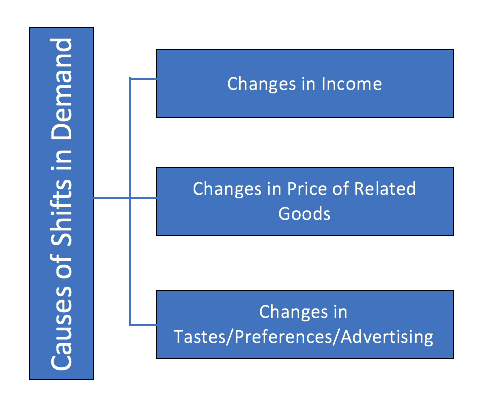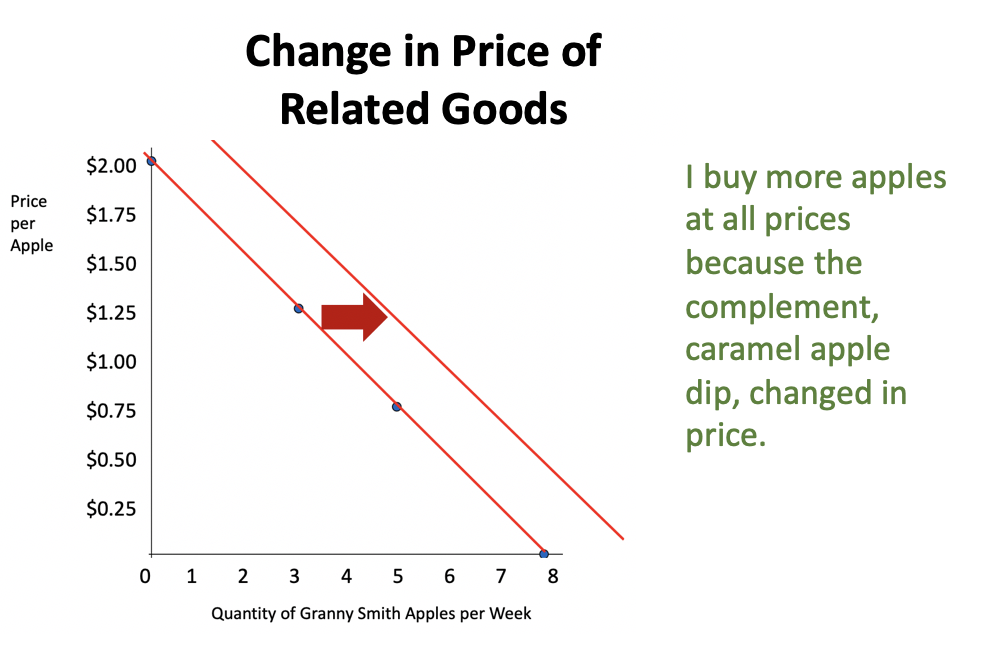Movements along a demand curve occur when the price of the product changes and impacts the quantity demanded.
Here is an example of a demand schedule featuring Granny Smith apples.
| Price of Granny Smith Apples | Quantity of Granny Smith Apples Each Week |
|---|---|
| $2.00 | 0 |
| $1.75 | 1 |
| $1.50 | 2 |
| $1.25 | 3 |
| $1.00 | 4 |
| $0.75 | 5 |
| $0.50 | 6 |
| $0.25 | 7 |
| $0.00 | 8 |
Notice the price per apple. For this particular demand schedule, apparently $2.00 per apple is too expensive and the point at which a customer chooses not to buy any apples.
Also notice that as the price falls, the quantity purchased increases.
Here is the demand graph created by plotting the points on the demand schedule, putting price on the y-axis and the quantity purchased on the x-axis.

As you can see on the graph, at $2.00, no apples are purchased. At the other end of the spectrum, if the apples are free, this customer purchases eight, approximately one for every day of the week.

Now, this is a downward sloping demand curve, because as items become less expensive, we buy more, as demonstrated by movement along the demand curve. The only variable changing is price.
In economic terminology, as price goes up, the quantity demanded rises, and vice versa. Again, there is an inverse relationship between the two which can be shown by movement along the demand curve.
This movement along a demand curve assumes a concept known as ceteris paribus, which means holding all other variables constant.
So, as the price of Granny Smith apples rises, we can expect that people will buy fewer of them because they are more expensive, assuming that only the price of Granny Smith apples has changed.
The price of Gala apples didn't change, nor did the price of oranges or bananas, or any other fruit. Our income did not change. Ceteris paribus is telling us that nothing else other than the price changed.
However, in the real world, we know that things are constantly changing other than the price of one good. Therefore, we need to address the result if something other variable changes.
Here is a demand schedule with the same prices as before, but notice that now, we are purchasing a different quantity.
| Price of Granny Smith Apples | Quantity of Granny Smith Apples Each Week |
|---|---|
| $2.00 | 0 |
| $1.75 | 0 |
| $1.50 | 0 |
| $1.25 | 0 |
| $1.00 | 1 |
| $0.75 | 2 |
| $0.50 | 3 |
| $0.25 | 4 |
| $0.00 | 5 |
In this scenario, either because we read that Granny Smith apples aren't as healthy or our income changed, we are now not buying any of them until they reach a price of $1.00. In fact, when they are $0.25, we are only buying four. When they're free, we are only buying five.
Because of this, there is a new relationship now between price and quantity, which requires a whole new demand curve like the one below.
This represents a shift in demand, which is a change in something other than price that affects purchasing behavior.

Here is a summary of the factors that cause a shift in demand. We will cover each of these in further detail:

Let's refer to the graph illustrating a decrease in demand. Remember, the price of Granny Smith apples didn't change, but if you make less money, you cannot afford as many and will buy fewer apples at all prices. Therefore, demand shifted to the left.

EXAMPLE
If Granny Smith apples are the only type of apple that becomes more expensive, the quantity demanded for them will decrease, which is expressed as movement along the Granny Smith apple demand curve. However, how do consumers respond?EXAMPLE
Suppose you eat apples and caramel apple dip together. If caramel apple dip goes on sale, you buy more, which is expressed as movement along the demand curve for caramel apple dip. However, even though the price of apples didn't change, you're also going to buy more apples to go with your caramel apple dip. This represents a change in demand for apples, or a shift of the demand curve to the right. The price of apples did not change, yet you are buying more of them, because the complement good changed in price.
EXAMPLE
For example, the child's toy Tickle Me Elmo was featured on a popular television show, so every parent in the market wanted to purchase it for their child, resulting in a massive increase in demand.Negative news reports or fads going out of style result in a decrease in demand.
EXAMPLE
Suppose you hear on the news tonight that there was an E. coli outbreak in spinach in your local area. At all prices, people will be purchasing less spinach, which is a decrease in demand.Source: Adapted from Sophia instructor Kate Eskra.